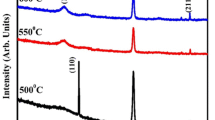Abstract
We have investigated the effect of post deposition annealing (PDA) temperature of Al2O3 blocking layer on the performance of charge trapping memory capacitors. Two splits of PDA were performed in N2 ambient at 850°C/60 s and 1050°C/60 s, respectively. The 1050°C annealed capacitor could be programmed and erased normally by using Fowler-Nordheim (FN) injection. In contrast, the 850°C annealed device could not be erased, even though it could be programmed properly. By measuring the gate leakage current and the flatband voltage shift, we found the erase failure in the 850°C annealed device was due to a larger gate back-injection leakage current at V g<0. The trend of gate leakage current was further verified in two Al/Al2O3/SiO2/p-Si control capacitors with the same PDA splits. In addition, constant voltage stress measurements on control capacitors in the FN regime showed that the change of gate leakage current followed an empirical Curie-von Schweidler law at V g<0. The data pointed out the importance to further study the relation between PDA conditions and the defect generation properties in Al2O3 blocking layer.
Similar content being viewed by others
References
Gan W, White M H. Characterization of scaled MANOS nonvolatile semiconductor memory (NVSM) devices. Solid State Electron, 2008, 52: 1491–1497
Kang C Y. Barrier engineering in metal-aluminum oxide-nitride-oxide-silicon (MANOS) flash memory. Curr Appl Phys, 2010, 10: e27–e31
Wellekens D, Blomme P, Govoreanu B, et al. Al2O3 based flash interpoly dielectrics: Acomparative retention study. In: Proceedings of the European Solid-State Device Research Conference, Montreux, Switzerland, 2006. 238–241
Beug M F, Melde T M, Czernohorsky M, et al. Analysis of TANOS memory cells with sealing oxide containing blocking dielectric. IEEE Trans Electron Devices, 2010, 57: 1590–1596
Wellekens D, Vos J D, Houdt J V, et al. Optimization of Al2O3 interpoly dielectric for embedded flash memory applications. In: Proceedings of Joint Non-Volatile Semiconductor Memory Workshop and International Conference on Memory Technology and Design, Opio, France, 2008. 12–15
Afanas’ev V V, Stesmans A, Mrstik B J, et al. Impact of annealing-induced compaction on electronic properties of atomic-layer-deposited Al2O3. Appl Phys Lett, 2002, 81: 1678–1680
Lisiansky M, Heiman A, Kovler M, et al. SiO2/Si3N4/Al2O3 stacks for scaled-down memory devices: Effects of interfaces and thermal annealing. Appl Phys Lett, 2006, 89: 153506
Hauser J. CVC-1996 NCSU Software. 3rd ed. Dept Elect Comput Eng North Carolina State Univ, Raleigh, NC, 1996
Kerbe A, Cartier E, Degraeve R, et al. Charge trapping and dielectric reliability of SiO2-Al2O3 gate stacks With TiN electrodes. IEEE Trans Electron Devices, 2003, 50: 1261–1269
Suhane A, Arreghini A, Bosch G V d, et al. Experimental assessment of electrons and holes in erase transient of TANOS and TANVaS memories. IEEE Electr Device L, 2010, 31: 936–938
Gildenblat G. Compact Modeling: Principles, Techniques and Applications. New York: Springer, 2010. 332–335
Bocquet M, Molas G, Perniola L, et al. Impact of a HTO/Al2O3 bi-layer blocking oxide in nitride-trap non-volatile memories. Solid State Electron, 2009, 53: 786–791
Gritsenko V A, Nekrashevich S S, Vasilev V V, et al. Electronic structure of memory traps in silicon nitride. Microelectron Eng, 2009, 86: 786–791
Ielmini D, Spinelli S A, Rigamonti A M, et al. Modeling of SILC based on electron and hole tunneling—Part I: Transient effects. IEEE Trans Electron Devices, 2000, 47: 1258–1265
Padovani A, Larcher L, Heh D, et al. Modeling TANOS memory program transients to investigate charge-trapping dynamics. IEEE Electr Device L, 2009, 30: 882–884
Rahman M S, Evangelou E K, Androulidakis I I, et al. SILC decay in La2O3 gate dielectrics grown on Ge substrates subjected to constant voltage stress. Solid State Electron, 2010, 54: 979–984
Campabadal F, Rafí J M, Zabala M, et al. Electrical characteristics of metal-insulator-semiconductor structures with atomic layer deposited Al2O3, HfO2, and nanolaminates on different silicon substrates. J Vac Sci Technol B, 2011, 29: 01AA07
Author information
Authors and Affiliations
Corresponding author
Rights and permissions
About this article
Cite this article
Jin, L., Zhang, M., Huo, Z. et al. Effect of high temperature annealing on the performance of MANOS charge trapping memory. Sci. China Technol. Sci. 55, 888–893 (2012). https://doi.org/10.1007/s11431-011-4703-7
Received:
Accepted:
Published:
Issue Date:
DOI: https://doi.org/10.1007/s11431-011-4703-7




